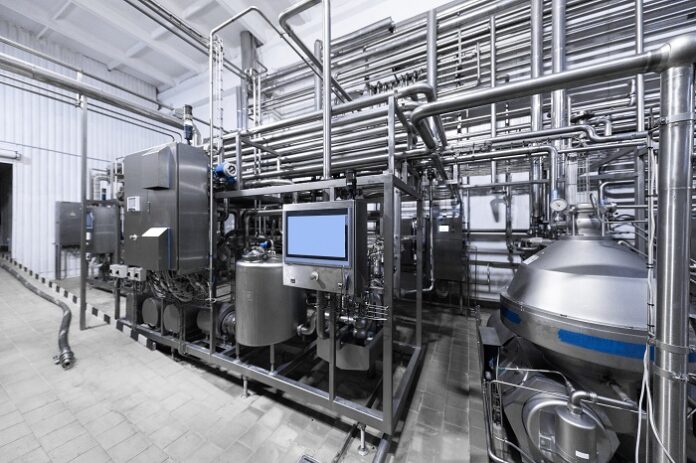The dairy industry, a cornerstone of global agriculture, has experienced profound transformations over the centuries. From manual milking to mechanized processes, the evolution has been marked by continuous innovation.
Today, the industry stands at the cusp of a new era, fueled by the rapid advancement of technology. This change is not just about enhancing efficiency; it’s about meeting the dynamic demands of consumers, adhering to stringent regulatory standards, and achieving sustainability goals. In this blog, we will delve into the latest trends in dairy processing equipment that are not just reshaping the industry but are setting the stage for a future where technology and tradition converge in harmony.
Automation and Robotics
Robotic milking systems have revolutionized dairy farming, significantly impacting productivity, labor costs, and overall farm management. These systems offer a myriad of benefits, including improved milk yield and quality, enhanced animal welfare, and the reduction of manual labor requirements.
One of the key advantages of robotic milking systems is their ability to free up time for farmers by automating the milking process. This allows farmers to focus on other critical aspects of farm management and animal care. Automation in milking not only minimizes the physical labor involved but also contributes to a more consistent and hygienic milking process, which in turn improves milk quality.
Robotic systems provide real-time data on each cow’s milk production, health indicators, and behavior patterns, enabling farmers to make informed decisions regarding breeding, nutrition, and herd management. This data-driven approach aids in proactive veterinary care and early detection of potential issues, leading to improved herd management and increased profitability.
The adoption of robotic milkers also reflects a significant reduction in labor costs, with many farms reporting a decrease in the need for manual labor for milking operations. This labor-saving aspect is particularly appealing in regions where there is a shortage of skilled labor or where labor costs are high.
However, integrating robotic milking systems into dairy farms is not without its challenges. The initial investment can be substantial, and there’s a learning curve for both the farmers and the cows. Regular maintenance, addressing technical issues, and training staff are critical for the smooth operation of these systems.
Despite these challenges, the adoption of robotic milking systems is on the rise, driven by their potential to enhance efficiency, productivity, and sustainability on dairy farms. As technology continues to advance, it’s expected that more farms will embrace this innovation, further transforming the dairy industry.
Advanced Filtration Technologies
As we delve deeper into the innovations shaping the dairy industry, advanced filtration technologies stand out for their role in enhancing product quality and sustainability. Techniques such as microfiltration and ultrafiltration are at the forefront of this transformation, offering dairy processors the tools to not only refine the efficiency of dairy processing but also to innovate in the creation of novel dairy products.
These filtration technologies work by removing particulates and microorganisms from milk, resulting in products that are not only safer for consumption but also of a higher quality. For instance, microfiltration can significantly reduce bacteria levels, extending the shelf life of dairy products without the need for added preservatives. Ultrafiltration, on the other hand, concentrates and separates protein components, enabling the production of specialized dairy products tailored to specific dietary needs or consumer preferences.
Moreover, these advanced filtration methods align with the industry’s sustainability goals by reducing waste and improving water management. By recapturing valuable components that would otherwise be lost and reducing the reliance on chemical treatments, dairy processors can minimize their environmental footprint while maximizing the nutritional value of their products.
Energy Efficiency and Sustainability
The integration of Energy Efficiency and Sustainability initiatives within the dairy industry has led to the advancement of cheese processing machinery, aligning with the sector’s commitment to reducing environmental impact. Innovations in cheese processing equipment are not only enhancing operational efficiency but are also paving the way for the adoption of practices that significantly reduce energy consumption and minimize waste. This focus on sustainability is particularly evident in the development of energy-efficient cheese vats, curd handling systems, and packaging lines that ensure the dairy sector’s operations are more sustainable and cost-effective.
By leveraging state-of-the-art cheese processing machinery that emphasizes energy efficiency, dairy processors are able to lower their carbon footprint while maintaining high production standards. These advancements contribute to the industry’s broader goals of sustainability by optimizing energy use, reducing waste, and utilizing renewable energy sources wherever possible. Furthermore, the adoption of water recycling technologies in cheese production processes underscores the dairy industry’s role in promoting environmental stewardship.
The evolution of cheese processing machinery reflects the dairy industry’s proactive approach to addressing environmental challenges. It exemplifies how technological innovation can achieve a balance between meeting consumer demand for high-quality cheese products and the imperative to operate in an environmentally responsible manner. This commitment to sustainability and efficiency is reshaping the future of cheese production, setting a benchmark for other sectors within global agriculture to follow.
Safety and Hygiene Enhancements
In the dairy industry, product safety and hygiene are paramount. Advancements in dairy processing equipment are setting new standards in ensuring the highest levels of safety and cleanliness. Automated cleaning systems, for instance, provide thorough and consistent sanitation, reducing the risk of contamination and ensuring that dairy products are safe for consumption. Moreover, touchless technology is gaining traction, minimizing human contact with the product and thereby further enhancing the hygienic quality of dairy processing.
These enhancements are crucial not only for consumer safety but also for compliance with increasingly stringent food safety regulations. By incorporating these advanced technologies, dairy processors can not only meet but exceed regulatory standards, ensuring their products are trusted by consumers and authorities alike.
Challenges and Considerations
While the integration of new technologies in the dairy processing industry offers numerous benefits, it also presents challenges. The cost of adopting cutting-edge equipment can be prohibitive for smaller operations, and the complexity of these technologies may require additional training for staff. Moreover, scalability is a critical consideration, as processors need to ensure that the technologies they invest in can grow with their business.
However, the potential rewards of embracing these technologies—increased efficiency, improved product quality, enhanced sustainability—are compelling. For dairy processors willing to navigate these challenges, the future is bright. The key is in carefully selecting technologies that align with their specific production goals and operational capacities.
Conclusion
The latest trends in dairy processing equipment are not just transforming the industry; they’re redefining what’s possible in dairy production. From enhancing efficiency and sustainability to meeting the demand for personalized products, these innovations offer a blueprint for the future of dairy processing. As the industry continues to evolve, embracing these technologies will be crucial for dairy processors aiming to stay competitive in an ever-changing market. The future of dairy is not only high-tech but also greener, more personalized, and safer than ever before—a promising horizon for processors, consumers, and the planet alike.





